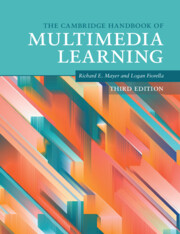Book contents
- The Cambridge Handbook of Multimedia Learning
- The Cambridge Handbook of Multimedia Learning
- Copyright page
- Contents
- Figures
- Tables
- Contributors
- Preface
- Acknowledgments
- Part I Background
- Part II Theoretical Foundations
- Part III Basic Principles of Multimedia Learning
- Part IV Principles for Reducing Extraneous Processing in Multimedia Learning
- Part V Principles for Managing Essential Processing in Multimedia Learning
- Part VI Principles Based on Social and Affective Features of Multimedia Learning
- 22 Principles Based on Social Cues in Multimedia Learning
- 23 The Embodiment Principle in Multimedia Learning
- 24 The Immersion Principle in Multimedia Learning
- 25 The Collaboration Principle in Multimedia Learning
- 26 The Animation Composition Principle in Multimedia Learning
- 27 The Emotional Design Principle in Multimedia Learning
- Part VII Principles Based on Generative Activity in Multimedia Learning
- Part VIII Multimedia Learning with Media
- Author Index
- Subject Index
- References
25 - The Collaboration Principle in Multimedia Learning
from Part VI - Principles Based on Social and Affective Features of Multimedia Learning
Published online by Cambridge University Press: 19 November 2021
- The Cambridge Handbook of Multimedia Learning
- The Cambridge Handbook of Multimedia Learning
- Copyright page
- Contents
- Figures
- Tables
- Contributors
- Preface
- Acknowledgments
- Part I Background
- Part II Theoretical Foundations
- Part III Basic Principles of Multimedia Learning
- Part IV Principles for Reducing Extraneous Processing in Multimedia Learning
- Part V Principles for Managing Essential Processing in Multimedia Learning
- Part VI Principles Based on Social and Affective Features of Multimedia Learning
- 22 Principles Based on Social Cues in Multimedia Learning
- 23 The Embodiment Principle in Multimedia Learning
- 24 The Immersion Principle in Multimedia Learning
- 25 The Collaboration Principle in Multimedia Learning
- 26 The Animation Composition Principle in Multimedia Learning
- 27 The Emotional Design Principle in Multimedia Learning
- Part VII Principles Based on Generative Activity in Multimedia Learning
- Part VIII Multimedia Learning with Media
- Author Index
- Subject Index
- References
Summary
The collaboration principle in multimedia learning states that collaborative learning is most effective when the distribution advantage learners experience during collaborative learning (i.e., the cognitive benefit learners experience from being able to share the burden of information processing with team members) is larger than the transaction costs learners also experience (i.e., the cognitive demands placed on individual learners due to the need to communicate, coordinate, and regulate their actions). The design of multimedia environments may affect the outcomes of collaborative learning in a positive way, for example, by increasing the distribution advantage of learners by offering tools that facilitate sharing of information, or by lowering the transaction costs of collaboration by offering tools for effective communication.
Keywords
- Type
- Chapter
- Information
- The Cambridge Handbook of Multimedia Learning , pp. 304 - 312Publisher: Cambridge University PressPrint publication year: 2021
References
- 3
- Cited by

